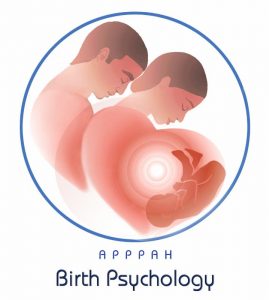APPPAH is proud to announce a collaboration with In Utero filmmakers, Kathleen and Stephen Gyllenhaal, and Kindred Media and Community to create a powerful and practical In Utero Film Discussion and Resource Guide. (It’s a large file so be patient!)
After a wildly successful year of international film festivals, awards and translation into ten languages, In Utero was released for on demand viewing in October 2016. Audiences quickly arranged home, university and clinic screenings, eager to discover and discuss the film’s cinematic and epic journey through the revelation that “womb ecology becomes world ecology.”
Over the past year, the ground breaking, intense film received a spectrum of reactions: from professionals who are grateful for the careful integration of multiple fields of science to some “triggered” audience members who walked out of public screenings. Birth professionals and midwives were concerned about new parents or pregnant mothers viewing the film without guidance. The filmmakers themselves have cautioned audiences that this film’s “dark message” was necessary to “outline the problem” and may not be suitable for some pregnant mothers.
Why Is A Film Guide Needed?
In Utero’s mission is to present “a cinematic rumination on what will emerge as the most provocative subject of the 21st Century – life in the womb and its lasting impact on human development, human behavior, and the state of the world.” As the filmmakers share in their Kindred interview from October 2016, In Utero “outlines the problem” facing humanity by presenting 50 years of diverse fields of science that, independent of one another, all arrive at one conclusion: Womb Ecology Becomes World Ecology.
Through well-organized subsections, with titles like Breeding Hostility and Beyond the Blueprint, the film tackles the complex science of epigenetics, transgenerational trauma, and the human psyche’s attempts to resolve birth trauma through mythology, especially fairy tales and pop culture movies like Alice in Wonderland and The Matrix. A dozen international experts – including Gabor Maté, MD, Rachel Yehuda, PhD, and Thomas Verny, MD — weave a coherent tapestry of diverse scientific insights amid scenes of a fetus jolting at the sound of parents arguing, caged monkeys deprived of mothering attacking each other and aerial shots of industrial agriculture and other modern ecological hell holes.
The Gyllenhaals acknowledge in their Kindred interview that the film is “dark” because it is necessary to explore and “outline the problem” humanity is clearly facing in daily headlines, including the basic question, “How will we survive as a species with industrial values dominating human values?” (Download audio or read transcript here.) While the filmmakers explore deeper insights and potential “solutions” in their Huffington Post blog(, are planning a television show, Making Modern Babies, and intend to film an In Utero 2 to explore “the solutions” to the problem presented in the first In Utero, eager groups are gathering to study the film now and are asking for guidance.
Over the past year, we’ve listened carefully to your feedback and will continue to do so. Unlike any medium in our time, In Utero possesses the potential to open doors to an especially welcome and needed discussions on “How did we get here?” Here is a sampling of what we’ve found so far, and, on page six, we will share with you how to approach and utilize this important work.
Gathering Your Feedback And Stories About Viewing The Film
From the beginning, the Association for Prenatal and Perinatal Psychology and Health, APPPAH, and its nonprofit media partner, Kindred, championed the educational opportunity In Utero provided for the public, professionals and parents… or anyone who was born. In support of the film’s message, APPPAH board members served as panelists at In Utero’s world premier in June 2015 at the Seattle International Film Festival, screened the film at APPPAH’s 19th International Congress in Berkeley, California, in December 2015 and again at APPPAH’s Regional Conference in September 2016.
As an alternative media and nonprofit educational initiative, Kindred promoted the story behind the film with interviews with the filmmakers, film presenters, and birth psychology pioneers. Capitalizing on a year of discussions and feedback, APPPAH and Kindred collaborated to create an In UteroFilm Discussion and Resource Guide with the blessings of the filmmakers.
Upon the film’s release in October 2016, audiences quickly organized at home group screenings of the film. The reactions to the film and stories began to accumulate and soon we could see our way ahead, and the importance of a guide. (Please continue to send me your feedback at [email protected])
Who Should See The Film?
Should pregnant mothers see the film? In an interview with Kindred, filmmaker Kathleen Gyllenhaal said, “I really feel it is almost 50/50. Some women come up to me pregnant and just thrilled that this film is there. They understand that it is tough, but they are grateful to have this information. I myself, having been pregnant during the making of this film and being hyper aware that all of the stress studies and all of the stress that impacts the fetus in pregnant women and so I had to navigate through all of that and I was angry. I was frustrated. The irony was not lost on me. How do I get rid of this stress so I can be a wonderful vessel for my child? But, you know, learning what I learned helped me find some ways to reduce that stress and so I think it really depends on the woman, the mother, herself. I think it is up to her to decide.”
Samsarah Morgan, executive director at the Oakland Better Birth Foundation, held an on demand screening for her childbirth class. Pregnant mothers, childbirth educator students and other parents watched the film and discussed its impact on them afterwards. “I sat in the corner out of the way to gauge their reactions so I would know how to lead the discussion,” said Morgan. “I cried while watching a young mother realize ‘this is my baby.’ After the film she said she had an instinct that that was the case but other people were telling her that it wasn’t true. I was crying watching her watch this movie. She was crying about what this meant for her and her baby.”
At a home screening of the film to a group of birth psychology professionals in Charlottesville, Virginia, the discussion turned to the film’s excellent presentation of “the problem,” but its shortfall in presenting the existing resources and healing modalities available for anyone wishing to explore their birth imprints, and the blueprint for wholeness beneath it. Marti Glenn, PhD, Clinical Director of Quest Institute in Santa Barbara, California, pointed out, “The film is theoretical. It does not delve into the known and applied modalities for addressing and healing birth trauma.” (You can read the full reactions from Morgan and Glenn in a feature in Somatic Psychotherapy Today’s Winter 2017 issue online February here.)
“We had a spirited discussion about it,” said Glennie Feinsmith, a Birth Integration therapist, of an Oregon screening. “If people can put the dots together, perhaps they’ll understand the inner rage that persists and is growing in our country, sourcing the chaos we are seeing politically right now.”
How To Use This Guide
It is our intention in this guide to introduce within the film’s 14 themed chapters an “outline of the solution” available now – the empowering healing worldview and practical modalities of birth psychology initiated with APPPAH’s founding in 1981. APPPAH’s director of education, Kate White, gently guides your group into a positive and reassuring approach to the film on page six before diving into the Discussion Ideas for each section. Three pages of resources provide a glimpse into the extensive support and knowledge also available, right now. As you will discover, “the problem” outlined in the film comes with many healing and empowering tools for professionals, parents and anyone who experienced birth, most importantly your own.
It is APPPAH’s co-founder, Thomas Verny, MD, who coined the phrase, “Womb Ecology Becomes World Ecology” over three decades ago. Today, APPPAH offers professional educator certificates in birth psychology and a parent education program, The Conscious Baby launches in 2017. Keep up with current headlines and features from the world of birth psychology at the online newspaper The Conscious Baby at www.TheConsciouBaby.com. The last two pages of this guide provide an overview of APPPAH’s programs.
If you need support in using this film guide or organizing your discussion group, feel free to contact APPPAH at [email protected]. If you would like to host a large public screening. contact the In Utero team here. Thank you so much in advance for your commitment to healing ourselves and our world.
Download the In Utero Film Discussion and Resource Guide here.
Article originally published on www.birthpsychology.com and is reprinted here with permission.








